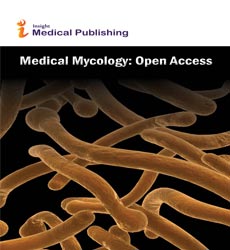The Phylogenetic Examinations of DNA Groupings
Andi M Wilson
DOI10.36648/2471-8521.21.7.e007
Andi M Wilson*
Department of Biochemistry, University of Pretoria, Hatfield Campus Pretoria, South Africa
- *Corresponding Author:
- Andi M Wilson
Department of Biochemistry, University of Pretoria, Hatfield Campus Pretoria, South Africa
E-mail: wilsonam@fabi.up.ac.za
Received date: July 19, 2021; Accepted date: August 02, 2021; Published date: August 09, 2021
Citation:Andi M Wilson(2021) The PhylogeneticExaminations of DNA Groupings. Med Mycol Open Access Vol.7 No. 4: e007
Introduction
Ascomycota is a monophyletic bunch (it contains all relativesof one normal progenitor). Recently positioned in theDeuteromycota alongside biogenetic species from otherparasitic taxa, agamic (or anamorphic) ascomycetes arecurrently distinguished and arranged dependent onmorphological or physiological likenesses to ascus-bearing taxa,and by phylogeneticexaminations of DNA groupings. Theascomycetes are of specific use to people as wellsprings oftherapeuticallysignificant mixtures, like anti-infection agents,for maturing bread, cocktails and cheddar. Penicillium species oncheeses and those creatinganti-infection agents for treatingbacterial irresistible sicknesses are instances of ascomycetes.Ascomycota is a phylum of the realm Fungi that, along with theBasidiomycota, shapes the subkingdom Dikarya. Its individualsare usually known as the sac organisms or ascomycetes. It is thebiggest phylum of Fungi, with more than 64,000 species. Thecharacterizing element of this contagious gathering is the"ascus” a minuscule sexual construction wherein nonmotilespores, called ascospores, are framed. Nonetheless, a few typesof the Ascomycota are agamic, implying that they don't have asexual cycle and subsequently don't shape asci or ascospores.Natural instances of sac parasites incorporate morels, truffles,brewer's yeast and pastry specialist's yeast, dead man's fingers,and cup organisms. The parasitic symbionts in most of lichens(inexactly named "ascolichens, for example, Cladonia have aplace with the Ascomycota. The variety was first portrayed in thelogical writing by Johann Heinrich Friedrich Link in ordinesplantarum naturales; he stated, "Penicillium, where penicillatisalluded to "pencil-like" (alluding to a Camel's hair pencil brush.Connection included three species—P. candidum, P. expansum,and P. glaucum—all of which created a brush-like conidiophore(agamic spore-delivering structure). The normal apple decaygrowth Penicillium was subsequently chosen as the sort species.John I. Pitt separated Penicillium into four subgenera dependenton conidiophore morphology and expanding design:Aspergilloides, Biverticillium, Furcatum, and Penicillium. Speciesremembered for subgenus Biverticillium were subsequentlyconverged into Talaromyces.Individuals from the phylum Ascomycota are known asascomycetes. Ascomycota is the biggest phylum of the realmgrowths and has around 64000 species. They go under the sub-realm Dikarya (presence of dikaryon). They produce sexual non-motile spores known as ascospores. They are created in a sac-like construction known as an ascus. Every ascus contains 4-8ascospores. They are regularly known as sac-parasites.Ascomycetes have an assorted environment and taking care ofpropensity, some are saprophytes though others aremicroorganism causing different illnesses in creatures andplants. A portion of the ascomycetes are palatable asmushrooms. Some of them live in a harmonious relationship aslichens and mycorrhiza. Normal instances of ascomycetesincorporate yeast, fine molds, cup growths, morels, truffles,Neurospora, Aspergillus, Cladonia, Penicillium, Candida,Claviceps, and so on Ascomycetes are financially vital. We getaged food (bread, cheddar, and cocktails), anti-toxins (Penicillin)and differentsynthetic compounds. Numerous species areutilized in organic investigations and exploration (yeast,Neurospora). Morels and truffles are utilized as luxuries.Ascomycetes are additionally ordered dependent on the variousdesigns of asci bearing constructions and strategies for thearrival of ascospores. In basidiomycetes the spores create onprojections that develop out from tiny cells called basidia, asopposed to being wrapped inside cells. As a rule the basidia arelengthened and club-like, however there is variety fit as a fiddle.Regularly, every basidium has four projections and four spores -yet a few animal varieties might have only one projection andspore for each basidium and others up to eight. In manybasidiomycetes the basidia have no isolating dividers (or septa);however in few genera the basidia are septate. The projectionsfrom the basidia are called sterigmata.
Open Access Journals
- Aquaculture & Veterinary Science
- Chemistry & Chemical Sciences
- Clinical Sciences
- Engineering
- General Science
- Genetics & Molecular Biology
- Health Care & Nursing
- Immunology & Microbiology
- Materials Science
- Mathematics & Physics
- Medical Sciences
- Neurology & Psychiatry
- Oncology & Cancer Science
- Pharmaceutical Sciences
